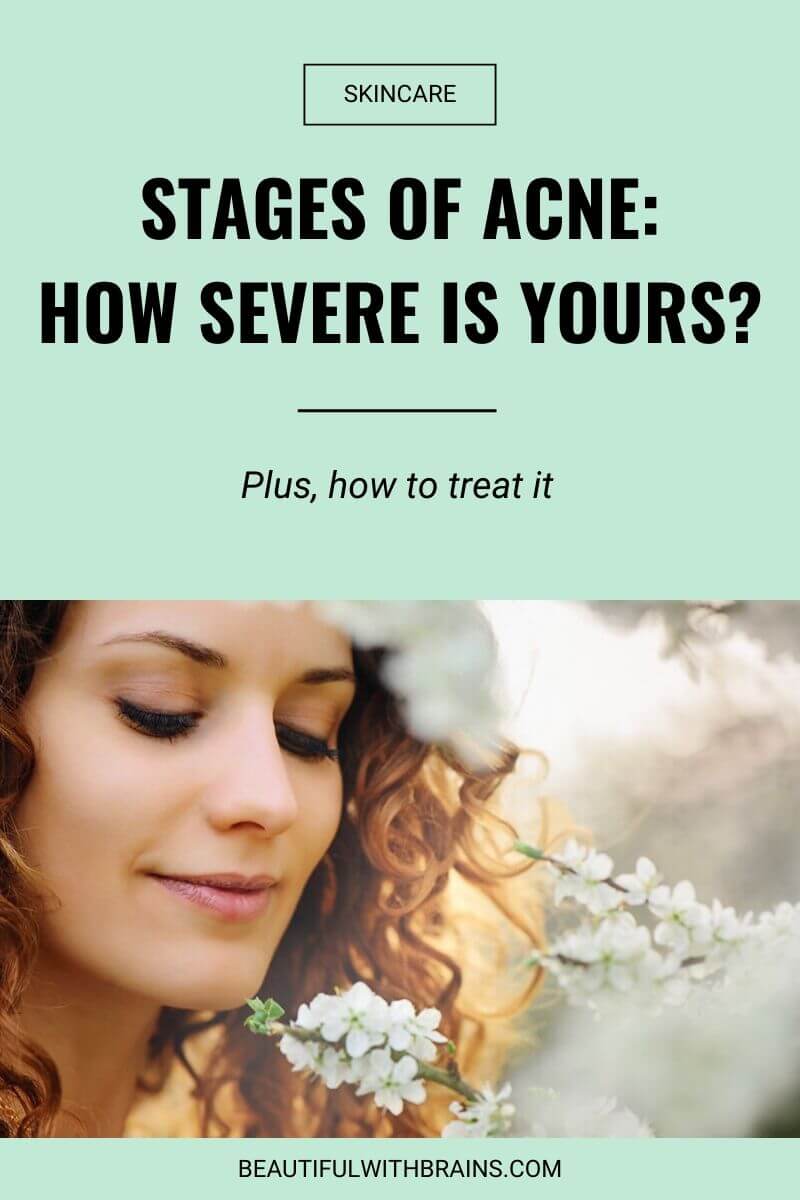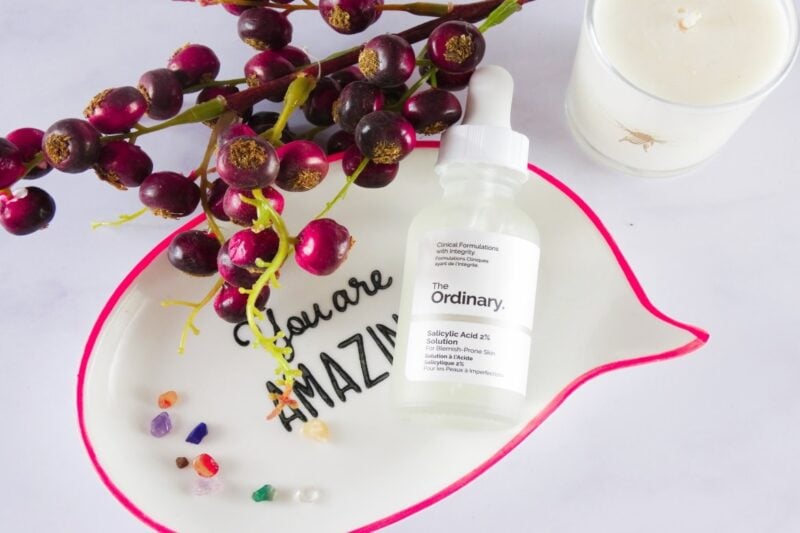
What acne stage are you in?
Acne doesn’t develop in a day. That ugly red pimple that’s just popped up on your chin has been in the making for weeks. It just decided to appear now.
FYI, if that’s all you’re dealing with, count yourself lucky. In the worst case scenario, pimples can turn into nodules and cysts that take a lot of time and work to heal.
Good news: you don’t need to get that far. Here’s how to deal with each stage of acne, so you can stop it from getting worse and finally achieve the clear skin you crave:
Acne Stage 1: Retention Hyperkeratosis
Did you know that normal, healthy skin exfoliates on its own? But when you’re dealing with retention hyperkatosis, dead cells become so cohesive, they refuse to budge.
They stay trapped into the skin, where they mix with excess sebum. It’s the beginning of microcomedones (micro pimples) underneath the skin. It’ll take roughly 8 weeks before the nasty bugger appears on the surface.
FYI, excess oil production plays a vital role here. It’s usually triggered by hormones like cortisol and testosterone. You’ve guessed it, there’s a genetic component here.
How To Treat Retention Hyperkeratosis
The sooner you tackle acne, the better. Help your skin keep those pores unclogged and you won’t have to deal with pimples a couple of months later. How?
1. SALICYLIC ACID
Exfoliation is key. Your skin isn’t doing the job too well, so you need to give it a helping hand. Enter salicylic acid.
Unlike other exfoliating acids, salicylic acid is oil-soluble. What does it mean? It can penetrate through the lipid layer of the skin and get deep inside the pores, unclogging them from within.
P.S. Salicylic Acid is also called BHA (Beta Hydroxy Acid).
Best Picks:
- Drunk Elephant T.L.C. Framboois Glycolic Night Serum: available at Cult Beauty, Sephora and SpaceNK
- Paula’s Choice Resist BHA 9 Targeted Solution ($43.00): available at Dermstore, Nordstrom and Paula’s Choice
- Paula’s Choice Skin Perfecting 2% BHA Liquid Exfoliant ($29.00): available at Dermstore, Look Fantastic, Paula’s Choice and Selfridges
Related: Why Salicylic Acid Is Key To Spot-Free Skin
2. RETINOIDS
Retinoid is the catch-all terms for all forms of Vitamin A. Their main gig is to fight wrinkles, but they can help with acne, too.
Retinoids work because they speed up cellular turnover, the skin’s natural exfoliating process. Anything that helps you shed dead skin cells will reduce your chance of getting pimples.
Prescription retinoids are the most effective – and the harshest. If you’re new to them, I recommend you start with small concentrations of OTC retinol twice a week and build up both dose and frequency from there.
Best Picks:
- Dr Dennis Gross Ferulic Acid + Retinol Brightening Solution ($88.00): available at Nordstrom, Sephora, and SpaceNK
- The Ordinary Granactive Retinoid 2% Emulsion (£8.00): available at Beauty Bay, Cult Beauty and Feel Unique
- Paula’s Choice Resist 1% Retinol Booster ($52.00): available at Dermstore, Feel Unique and Paula’s Choice
- Paula’s Choice Super Antioxidant Concentrate Serum With Retinol ($34.00): available at Dermstore and Paula’s Choice
Related: The Complete Guide To Retinol: What It Is, What It Does, And How To Use It
3. LIFESTYLE CHANGES
On top of exfoliating skin, you can also try and decrease sebum production with some lifestyle changes:
- Low Glycemic Diet: Too much sugar, dairy, and processed foods can inflame skin. Guess what acne is? An inflammatory disease. Keep these foods to a minimum.
- Oral contraceptives: They decrease the activity of testosterone, the hormone involved in the overproduction of sebum. Consult your doctor to find out which pill is most suitable for you.
- Stress management: Take a few minutes every day to do something that relaxes you, be it meditation, a relaxing bath or a walk in the park. Stress pumps out cortisol, which in turns increases the activity of your sebaceous glands. Anything that can bring it down a notch or two will help prevent acne (and all its other evils).
Related: I Went On The Low Glycemic Diet And It Transformed My Skin
Want a cheap skincare routine for acne-prone skin that really works? Subscribe to the newsletter below to receive “The Ordinary Acne Skincare Routine” cheatsheet:
Acne Stage 2: Bacteria Accumulation
This is when P.Acnes enters the scene.
P. Acnes is the bacteria that gives you acne. It thrives on sebum. It’s literally its fave food. When your skin produces too much, these bacteria start to accumulate and multiply. Ugh.
How To Treat Bacteria Accumulation
BENZOYL PEROXIDE
There’s a reason why derms love recommending Benzoyl Peroxide: it works. BP has antibacterial properties that kill P.Acnes.
We’re not 100% sure how it does it, but scientists think it works by generating free radicals in the sebaceous follicle.
In case you’re wondering, yes – free radicals are those nasty molecules that give you wrinkles and dark spots. That’s why you should NEVER use BP all over your face. Apply it on the affected area only.
The silver lining? Bacteria don’t grow resistant to Benzoyl Peroxide. You can always count on it to do the job.
Best Picks:
- La Roche Posay Effaclar Duo Dual Action Acne Treatment ($36.95): available at Dermstore and Feel Unique
- Paula’s Choice Clear Daily Skin Clearing Treatment With 5% Benzoyl Peroxide ($18.00): available at Dermstore and Paula’s Choice
- Proactiv Emergency Blemish Relief ($20.00): available at Sephora and Ulta
Related: Is Benzoyl Peroxide Good Or Bad For Your Skin?
Acne Stage 3: Blackheads And Whiteheads
As the clog in your pores gets bigger and bacteria keeps thriving in it, the microcomedone grows. At this point it can turn into:
- Blackhead: Or open comedone, it happens when the gunk stuck in your pores oxidises in contact with air, turning black.
- Whitehead: Or closed comedone, it happens when the opening of the pore is so small, air can’t oxidise the gunk inside it.
Both blackheads and whiteheads are known as grade 1 acne.
How To Treat Blackheads And Whiteheads
A combination of exfoliation and antibacterial agents works best.
In plain English, use salicylic acid every other night to unclog your pores. If you want to speed up the process, you can also apply Benzoyl Peroxide on the blackhead/whiteheads.
See stages 1 and 2 for the best exfoliant and Benzoyl Peroxide treatments to treat acne.
Related: How To Treat Blackheads

Acne Stage 4: Papules
So far, we’ve been dealing with non-inflammatory acne. But now, inflammation has entered the picture. Hint: things are starting to get worse.
All the excess sebum, dead cells, and bacteria trapped in the pores grows so big, it puts an incredible amount of pressure on the follicle. Next thing you know, the follicle wall ruptures.
The gunk inside spills into the surrounding skin, making it red, inflamed and sore. That red bump is a papule.
How To Treat Papules
BENZOYL PEROXIDE AND SULFUR
At this stage, there’s only one thing to do: kill P.Acnes. Again, Benzoyl Peroxide is your best bet. See stage 2 for my product recommendations.
Looking for a natural alternative, try sulfur. This mineral fights acne in several ways:
- It has antibacterial properties, so it kills the bacteria that cause acne
- It helps prevents acne-causing bacteria from spreading
- It helps exfoliate dead skin cells, accelerating cellular turnover and preventing breakouts
- It helps dry out blemishes
- It helps reduce oiliness, keeping breakouts at bay
The catch? It’s harsh and drying on the skin. Use it on pimples only!
Best Picks:
- Epionce Purifying Spot Gel ($38.00): available at at Dermstore
- ZO Skin Health Oeffects Sulfur Masque ($45.00): available at ZOSkinHealth
Related: Sulfur: Good For Acne, Bad For Skin?
Acne Stage 5: Pustules
Pustules happen in the same was as papules, but with a twist. Because of an infection in the pores, pustules usually contain pus.
This is the classic pimple with a white tip. It’s red, inflamed, and may be painful to the touch.
How To Treat Pustules
Pustules go away on their own, but you can speed up the process. Again, a combination of exfoliation and antibacterial agents is your best option.
Exfoliate regularly with salicylic acid to unclog the pores and use either Benzoyl Peroxide or sulfur on the pimple to kill P.Acnes.
See stages 1, 2, and 4 for best picks and product recommendations.
Related: Adult Acne: Why It Happens And How To Treat It

Acne Stage 6: Nodules
For most people, acne never gets much worse than a pimple. But in some cases, pustules turn into something worse. This is when things start to get really serious.
What does a pustule turn into? Nodules. An acne nodule is larger than your typical pimple. It’s inflamed. Painful. And affects the deeper layers of your skin.
How To Treat Acne Nodules
Exfoliate. Always. When you’re dealing with acne, you need to give your skin an extra helping hand at shedding those dead skin cells. It all started with them, remember?
But when you reach this stage, antibacterial agents like Benzoyl Peroxide and sulfur won’t cut it anymore. You need to see a dermatologist for a prescription treatment. Here are the most common:
- Isotretinoin: A prescription form of retinoids, it’s considered the best treatment for severe acne.
- Oral antibiotics: They reduce inflammation, so your skin looks better. But they’re for short-term use only.
- Oral contraceptive: Again, these can help regulate the production of sebum.
- Spironolactone: It limits the hormone fluctuations that cause breakouts.
Acne Stage 7: Cysts
Cystic acne is the worst type of acne. It happens when bacteria, excess sebum and dead cells get trapped in the pores, forming a cyst deep underneath your skin.
Cysts are large, red, and filled with pus. They’re also painful to the touch.
How To Treat Acne Cysts
You treat acne cysts the same way as you treat acne nodules. Isotretinoin, spironolactone, and all that jazz.
FYI, Isotretinoin is the active ingredient in Accutane. Use it only when nothing else does. It’s a last resort treatment for a reason: it has a lot of severe side effects, like depression, joint pain and birth defects.
Don’t be scared! If nothing else works, going on Accutane is worth it. But make sure you’ve exhausted all your other options first.
Related: Thinking Of Going On Accutane? Read This First
The Bottom Line
Exfoliation is always the first line of defence against acne. Do it regularly and you may not have to deal with pimples anymore. If it develops into pimples, add an antibacterial treatment. And if gets really severe, consult a dermatologist.

